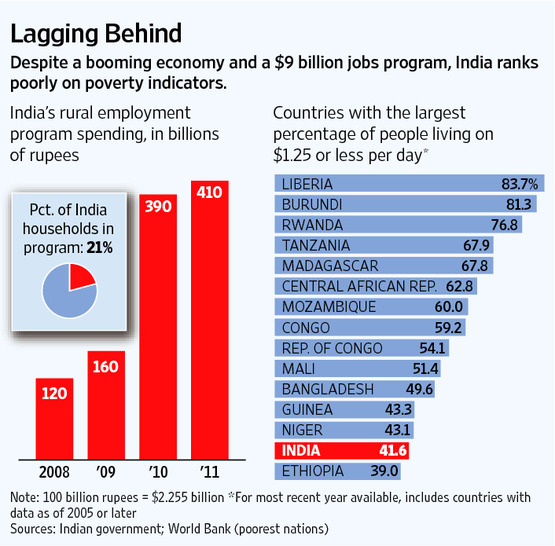Here's a piece by Soutik Biswas of the BBC on India's "distress migration":
Are millions of Indians being forced to leave their villages for cities and towns because there aren't enough jobs at home and farm incomes are drying up? Is this "distress migration" unprecedented in India's history?
Award-winning journalist P Sainath thinks so. Examining the latest census data, he finds that India's urban population has risen more (91 million more than in the 2001 census) than the rural population (90.6 million more than in the 2001 census). Nearly half the people in states like Tamil Nadu already live in urban settlements.
The last time, writes Mr Sainath, the rise in India's urban population exceeded the rise of the rural population was 90 years ago and reflected in the 1921 census. The decline in rural population then could be possibly linked to the 1918 flu pandemic that killed several million people.
This time around, Mr Sainath says, the increase in migration is driven by the "collapse of millions of livelihoods in agriculture and its related occupations". He writes that massive migrations "have gone hand-in-hand with a deepening agrarian crisis": more than 240,000 farmers, mostly broken by debt, committed suicide in India between 1995 and 2009.
'Despair-driven'
Mr Sainath has spent a lifetime reporting on distressed farmers and how the poor live in India. He admits that the census is not equipped to examine the complexity of migration in India. In a fast urbanising country, rising migration from villages to cities and towns is natural. Also, newer "urban areas" are being added all the time. The big picture is also not strikingly unusual. According to the census, 31.16% of Indians live in urban areas, up from 27.81% in 2001 - a rate which is actually significantly lower than the rate in many developing countries with similar income levels.
But, argues Mr Sainath, these "natural" factors which triggered migration from villages to cities have been valid in the earlier decades too when additions to the village population actually outstripped those to the cities. So why is the last decade throwing up a radically different result?...
----------
There may be other pressing questions to ponder. How does India cope with its increasing urban population? Its cities are choking under power cuts, scarcity of water and polluted air. Also the increase of new urban settlements with poor amenities and limited access to jobs could easily lead to massive social unrest among the migrants in the new "cities". Which could actually end up wrecking India's cities faster than its villages.
BBC News - Is India in the throes of 'distress migration'?
Are millions of Indians being forced to leave their villages for cities and towns because there aren't enough jobs at home and farm incomes are drying up? Is this "distress migration" unprecedented in India's history?
Award-winning journalist P Sainath thinks so. Examining the latest census data, he finds that India's urban population has risen more (91 million more than in the 2001 census) than the rural population (90.6 million more than in the 2001 census). Nearly half the people in states like Tamil Nadu already live in urban settlements.
The last time, writes Mr Sainath, the rise in India's urban population exceeded the rise of the rural population was 90 years ago and reflected in the 1921 census. The decline in rural population then could be possibly linked to the 1918 flu pandemic that killed several million people.
This time around, Mr Sainath says, the increase in migration is driven by the "collapse of millions of livelihoods in agriculture and its related occupations". He writes that massive migrations "have gone hand-in-hand with a deepening agrarian crisis": more than 240,000 farmers, mostly broken by debt, committed suicide in India between 1995 and 2009.
'Despair-driven'
Mr Sainath has spent a lifetime reporting on distressed farmers and how the poor live in India. He admits that the census is not equipped to examine the complexity of migration in India. In a fast urbanising country, rising migration from villages to cities and towns is natural. Also, newer "urban areas" are being added all the time. The big picture is also not strikingly unusual. According to the census, 31.16% of Indians live in urban areas, up from 27.81% in 2001 - a rate which is actually significantly lower than the rate in many developing countries with similar income levels.
But, argues Mr Sainath, these "natural" factors which triggered migration from villages to cities have been valid in the earlier decades too when additions to the village population actually outstripped those to the cities. So why is the last decade throwing up a radically different result?...
----------
There may be other pressing questions to ponder. How does India cope with its increasing urban population? Its cities are choking under power cuts, scarcity of water and polluted air. Also the increase of new urban settlements with poor amenities and limited access to jobs could easily lead to massive social unrest among the migrants in the new "cities". Which could actually end up wrecking India's cities faster than its villages.
BBC News - Is India in the throes of 'distress migration'?










